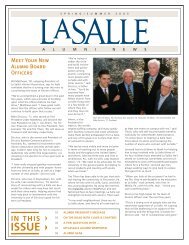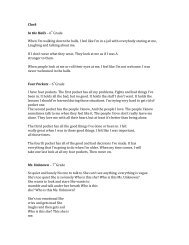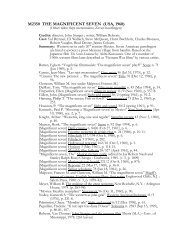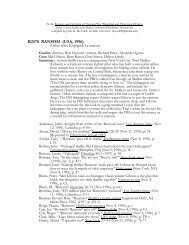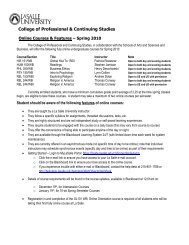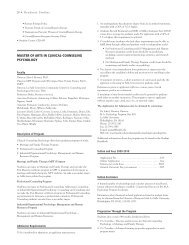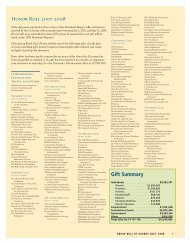How Hot is Your Sauce? - La Salle University
How Hot is Your Sauce? - La Salle University
How Hot is Your Sauce? - La Salle University
You also want an ePaper? Increase the reach of your titles
YUMPU automatically turns print PDFs into web optimized ePapers that Google loves.
<strong>How</strong> <strong>Hot</strong> <strong>is</strong> <strong>Your</strong> <strong>Sauce</strong>? Determination of Capsaicinoids in <strong>Hot</strong> Pepper<br />
<strong>Sauce</strong>s using HPLC<br />
Introduction:<br />
<strong>How</strong> hot <strong>is</strong> hot? Th<strong>is</strong> may sound like a very subjective question, but for nearly one hundred<br />
years, work has been done to attempt to quantify the bite that peppers can deliver. In the early<br />
1900's, pharmac<strong>is</strong>t Wilbur Scoville developed a method by which the "hotness" of a material <strong>is</strong><br />
quantified in terms of a Scoville Heat Index. Scoville's method was semi-quantitative at best<br />
and resulted from using a panel of tasters and determining the dilution needed to remove the<br />
hotness from a sauce or food. Using th<strong>is</strong> scale, hotness varied from zero units for bell peppers<br />
to upwards of 300,000 Scoville heat units for habenero peppers.<br />
In th<strong>is</strong> experiment, we will take a more quantitative approach to determining the "hotness" of a<br />
pepper-based sauce. The compounds responsible for the heat of a pepper are small organic<br />
molecules called capsaicinoids. The most common capsaicinoids are shown in Table 1 and<br />
vary only by the length and terminal structure of the hydrocarbon side chain.<br />
Objective:<br />
<strong>Your</strong> task in th<strong>is</strong> experiment <strong>is</strong> to extract the capsaicinoids from a sample of hot sauce and<br />
quantify their concentrations using HPLC with UV absorbance detection. In the process, you<br />
will explore means for developing and optimizing an HPLC separation, choosing a detection<br />
wavelength, and preparing standards for an analys<strong>is</strong>. You will not be given detailed instructions<br />
for the separation, but will be expected to develop a protocol to allow you to do the necessary<br />
determination.<br />
67
Procedural Guidelines:<br />
Required Chemicals and Solutions:<br />
1. A series of real-world capsaicin-containing sample, such as a hot sauce or hot pepper.<br />
2. HPLC Grade methanol (for mobile phase)<br />
3. 18 MΩ Res<strong>is</strong>tive Water<br />
4. Capsaicin standard for optimization of separation (labeled Capsaicin A)<br />
5. Capsaicin stock standard solution. (labeled Capsaicin B)<br />
6. 4 Standard capsaicin solutions.<br />
Extraction and Sample Prep:<br />
Accurately weigh 10-15 grams of hot sauce into a 125 mL Erlenmeyer flask. Add<br />
approximately 50 mL ethanol and a magnetic stirbar and heat the mixture at a low boil for<br />
~30 min (take care NOT to boil off all of the solvent!). While you are waiting for the solution<br />
to boil, use the time to collect a UV-V<strong>is</strong> spectrum of the capsaicin standard solution. After<br />
boiling, allow the mixture to cool to room temperature and filter the mixture into a 50 mL<br />
volumetric flask. Dilute the extract to the mark with ethanol. Prior to injection into the HPLC,<br />
perform a final filtration by passing ~2 mL of the diluted mixture through a 0.45 micron<br />
diameter pore size syringe filter, collecting the solution in a small plastic vial.<br />
HPLC Setup:<br />
You will be doing a reverse-phase separation using a C18 bonded-phase resin as the<br />
stationary phase and a methanol/water mixture as the stationary phase. Using the standard<br />
capsaicin A that has been prepared for you, you will need to determine a set of optimum<br />
conditions to use for your analys<strong>is</strong>. These conditions include: mobile phase composition,<br />
flow rate, and detection wavelength. Using a UV-V<strong>is</strong> spectrophotometer, collect a spectrum<br />
of the capsaicin standard and determine the optimum wavelength for the LC detector. You<br />
should see two peaks dominating the chromatograms of standards A, the first peak<br />
corresponds to capsaicin (C), and the second to dihydrocapsaicin (DC). In the standard, the<br />
two are present at a 65:35 (mM ratio) ratio (C:DC).<br />
Quantitative Analys<strong>is</strong>:<br />
In order to quantify the amount of capsaicinoid present in your sauce, you will need to<br />
prepare the appropriate standards and develop a calibration curve. Use the relative sizes of<br />
the capasaicin peaks in the stock solution and in your sample to determine the appropriate<br />
dilutions needed to prepare four standards whose concentrations bracket your sample. Use<br />
standard B (which <strong>is</strong> pure capsaicin) to prepare your standard solutions. Once the solutions are<br />
prepared, run injections of your standards and sample, as well as a blank to prepare your<br />
calibration curve. Run at least three injections of your sample to determine the prec<strong>is</strong>ion of<br />
the method. Prepare a running calibration curve to be sure that things are proceeding as<br />
expected. The chromatograms of your sample may also include a very large, early eluting<br />
peak corresponding to other components of the sauce. It may be necessary to rescale the<br />
68
y-ax<strong>is</strong> of your chromatogram to see the peaks of interest.<br />
Results:<br />
1. Plot a calibration curve and determine the least-squares line for your calibration data. Report<br />
the slope and intercept, as well as their standard deviations. Using calibration curves<br />
created by both peak areas and peak height, determine the total capsaicinoid concentration<br />
in your original sample (in both concentration units and in Scoville Heat Units). Format the data as<br />
shown below. Compare th<strong>is</strong> result to what you expect.<br />
2. It <strong>is</strong> also crucial to report the prec<strong>is</strong>ion of the analys<strong>is</strong> and ultimately the confidence limits. If<br />
possible, you should report the % error by compar<strong>is</strong>on of your calculated analyte<br />
concentration to that expected for your sample. Finally, with knowledge of your prec<strong>is</strong>ion<br />
and the calibration curve you obtained, you should be able to determine an approximate<br />
limit of detection for the method of analys<strong>is</strong>, under the experimental conditions you used for<br />
the measurement.<br />
3. What determinate errors might have played a role in impacting the accuracy of your results?<br />
What factors might have been the greatest contributors to the prec<strong>is</strong>ion you obtained during<br />
th<strong>is</strong> analys<strong>is</strong>.<br />
Time,<br />
min<br />
Chromatography Data System Report<br />
of Scoville "Heat" Units of Tabasco <strong>Sauce</strong><br />
Peak Area Component<br />
Name<br />
Amount,<br />
ng<br />
69<br />
Capsaicinoid,<br />
(%)<br />
Scoville<br />
units of pure<br />
capsaicinoid<br />
Scoville<br />
units in<br />
sample<br />
5.12 17343 NDC 3.37 0.001 9,300,000 78<br />
5.76 257942 Capsaicin 50.1 0.013 16,100,000 2020<br />
9.18 125620 DHC 24.4 0.006 16,100,000 984<br />
12.9 51739 HDC 10.0 0.003 8,100,000 204<br />
Total 88.0 0.022 328<br />
• Dong, M. W. Capsaicins in <strong>Hot</strong> Peppers; PE Brownlee LC Application Note: LCFD-25; Perkin-Elmer<br />
Corp.: Norwalk, CT, 1996.<br />
• Hoffman, P.G. et al., J. Agric. Food Chem. 1983, 31, 1326.




